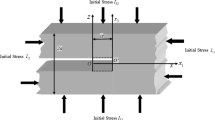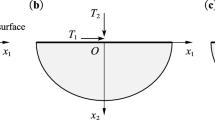Abstract
The dynamic response of an elastic thin plate resting on a cross-anisotropic elastic half-space to a rectangular load moving on its surface with constant speed is analytically obtained. The moving load and the plate and soil displacements are expanded in double complex Fourier series involving the two horizontal coordinates x and y as well as the time and the load velocity. Thus, the plate equation of lateral motion reduces to an algebraic equation, while the soil equations of motion reduce to a system of three ordinary differential equations with respect to the vertical coordinate z, which can be easily solved. Compatibility and equilibrium at the plate–soil interface as well as employment of the boundary conditions of the system enable one to determine the solution in terms of displacements of the plate and the half-space soil medium. The solution is first verified by using it to obtain as special cases the solutions for isotropic and cross-anisotropic half-space problems and compare them against existing analytical solutions. Parametric studies are conducted to assess the effects of the degree of cross-anisotropy on the plate and soil responses in conjunction with the effects of other important parameters, such as the speed of the moving load.





















Similar content being viewed by others
Change history
23 December 2020
In the version of the article originally published [1], Eqs.��(19)���(21) and (31) were shown incorrectly. The corrected equations are the following.
References
Beskou, N.D., Theodorakopoulos, D.D.: Dynamic effects of moving loads on road pavements: a review. Soil Dyn. Earthq. Eng. 31, 547–567 (2011)
Kim, S.H., Little, D.N., Masad, E., Lytton, R.L.: Estimation of level of anisotropy in unbound granular layers considering aggregate physical properties. Int. J. Pavement Eng. 6(4), 217–227 (2005)
Al-Qadi, I.L., Wang, H., Tutumluer, E.: Dynamic analysis of thin asphalt pavements by using cross-anisotropic stress-dependent properties for granular layer. Transp. Res. Rec. 2154, 156–163 (2010)
Ahmed, M.U., Tarefder, R.A., Islam, R.M.: Effects of unbound layer cross-anisotropy on pavement responses. Transportation Research Board 93rd Annual Meeting. 14-3588 12-16 (2014)
Cai, Y., Sangghaleh, A., Pan, E.: Effect of anisotropic base/interlayer on the mechanistic responses of layered pavements. Comput. Geotech. 65, 250–257 (2015)
Beskou, N.D.: Dynamic analysis of an elastic plate on a cross-anisotropic and continuously nonhomogeneous viscoelastic half-plane under a moving load. Acta Mech. 231, 1567–1585 (2020)
Beskou, N.D., Chen, Y., Qian, J.: Dynamic response of an elastic plate on a cross-anisotropic elastic half-plane to a load moving on its surface. Transp. Geotech. 14, 98–106 (2018)
Eason, G.: The stresses produced in a semi-infinite solid by a moving surface force. Int. J. Eng. Sci. 2, 581–609 (1965)
Payton, R.G.: Transient motion of an elastic half-space due to a moving surface force. Int. J. Eng. Sci. 5, 49–79 (1967)
Gakenheimer, D.C., Miklowitz, J.: Transient excitation of an elastic half-space by a point load traveling on the surface. J. Appl. Mech. ASME 36, 505–515 (1969)
De Barros, F.C.P., Luco, J.E.: Response of a layered viscoelastic half-space to a moving point load. Wave Motion 19, 189–210 (1994)
Jones, D.V., Le Houedec, D., Peplow, A.D., Petyt, M.: Ground vibration in the vicinity of a moving rectangular load on a half-space. Eur. J. Mech. 17(1), 153–166 (1998)
Grundmann, H., Lieb, M., Trommer, E.: The response of a layered half-space to traffic loads moving along its surface. Arch. Appl. Mech. 69, 55–67 (1999)
Georgiadis, H.G., Lykotrafitis, G.: A method based on the Radon transform for three-dimensional elastodynamic problems of moving loads. J. Elast. 65, 87–129 (2001)
Liao, W.I., Teng, T.J., Yeh, C.S.: A method for the response of an elastic half-space to moving sub-Rayleigh point loads. J. Sound Vib. 284, 173–188 (2005)
Cao, Y.M., Xia, H., Lombaert, G.: Solution of moving-load-induced soil vibrations based on the Betti–Rayleigh dynamic reciprocal theorem. Soil Dyn. Earthq. Eng. 30, 470–480 (2010)
Kim, S.M., Roesset, J.M.: Moving loads on a plate on elastic foundation. J. Eng. Mech. ASCE 124(9), 1010–1017 (1998)
Liu, C., McCullough, B.F., Oey, H.S.: Response of rigid pavements due to vehicle–road interaction. J. Transp. Eng. ASCE 126(3), 237–242 (2000)
Kim, S.M., McCullough, B.F.: Dynamic response of plate on viscous Winkler foundation to moving loads of varying amplitude. Eng. Struct. 25, 1179–1188 (2003)
Dieterman, H.A., Metrikine, A.: The equivalent stiffness of a half-space interacting with a beam. Critical velocities of a moving load along the beam. Eur. J. Mech. 15, 67–90 (1996)
Siddharthan, R.V., Yao, J., Sebaaly, P.E.: Pavement strain from moving dynamic 3D load distribution. J. Transp. Eng. ASCE 124(6), 557–566 (1998)
Kononov, A.V., Wolfert, R.A.M.: Load motion along a beam on a viscoelastic half-space. Eur. J. Mech. 19, 361–371 (2000)
Lu, Z., Yao, H.L., Luo, X.W., Hu, M.L.: 3D vibration of pavement and double-layered subgrade coupled system subjected to a rectangular moving load. Rock Soil Mech. 30, 3493–3499 (2009)
Payton, R.G.: Epicenter motion of a transversely isotropic elastic half-space due to a suddenly applied buried point source. Int. J. Eng. Sci. 17, 879–887 (1979)
Rajapakse, R.K.N.D., Wang, Y.: Green’s functions for transversely isotropic elastic half-space. J. Eng. Mech. ASCE 119(9), 1724–1746 (1993)
Wang, Y., Rajapakse, R.K.N.D.: Transient fundamental solutions for a transversely isotropic elastic half-space. Proc. R. Soc. Math. Phys. Sci. 442(1916), 505–531 (1993)
Eskandari-Ghadi, M., Pak, R.Y.S., Ardeshir-Behrestaghi, A.: Transversely isotropic elastodynamic solution of a finite layer on an infinite subgrade under surface loads. Soil Dyn. Earthq. Eng. 28, 986–1003 (2008)
Ba, Z., Liang, J., Lee, V.W., Ji, H.: 3D dynamic response of a multi-layered transversely isotropic half-space subjected to a moving point load along a horizontal straight line with constant speed. Int. J. Solids Struct. 100–101, 427–445 (2016)
Siddharthan, R., Zafir, Z., Norris, G.M.: Moving load response of layered soil. I: formulation; II: verification and application. J. Eng. Mech. ASCE 119(10), 2052-2071 & 2072-2089 (1993)
Theodorakopoulos, D.D.: Dynamic analysis of a poroelastic half-plane soil medium under moving loads. Soil Dyn. Earthq. Eng. 23, 521–533 (2003)
Beskou, N.D., Qian, J., Beskos, D.E.: Approximate solutions for the problem of a load moving on the surface of a half-plane. Acta Mech. 229, 1721–1739 (2018)
Cheng, A.H.D.: Poroelasticity. Springer, Cham (2016)
Szilard, R.: Theory and Analysis of Plates. Prentice-Hall, Englewood Cliffs (1974)
Weinberger, H.F.: A First Course in Partial Differential Equations: with Complex Variables and Transform Methods. Dover, New York (1995)
Buchwald, V.T.: Rayleigh wave in transversely isotropic media. Q. J. Mech. Appl. Mech. 14, 293–317 (1961)
Dieterman, H.A., Metrikine, A.: The equivalent stiffness of a half-space interacting with a beam. Critical velocities of a moving load along the beam. Eur. J. Mech. A/Solids 15, 67–90 (1996)
Ju, S.H., Lin, H.T., Huang, J.Y.: Dominant frequencies of train-induced vibrations. J. Sound Vib. 319, 247–259 (2009)
ABAQUS: ABAQUS Documentation. Dassault Systèmes, Providence (2017)
Chivers, I., Sleightholme, J.: Introduction to Programming with Fortran, 4th edn. Springer, Cham (2018)
Beskou, N.D., Tsinopoulos, S.V., Theodorakopoulos, D.D.: Dynamic elastic analysis of 3-D flexible pavements under moving vehicles: a unified FEM treatment. Soil Dyn. Earthq. Eng. 82, 63–72 (2016)
Acknowledgements
Dr. E.V. Muho and Professor J. Qian are grateful to the National Key Research and Development Program of China (Grant No. 2017YFC1500701) and the State Key Laboratory of Disaster Reduction in Civil Engineering (Grant No. SLDRCE15-B-06) for supporting this work.
Author information
Authors and Affiliations
Corresponding author
Additional information
Publisher's Note
Springer Nature remains neutral with regard to jurisdictional claims in published maps and institutional affiliations.
Appendices
Appendix A
The assumption that the plate extends to infinity along both directions x and y is an approximation for mathematical convenience. The correct solution involves finite plate dimension along the y-direction and can only be obtained by a numerical method. In order to validate the proposed method, elastic dynamic finite element analyses (FEA) have been conducted with the aid of the commercial program ABAQUS [38]. The half-space has been modeled with solid elements assuming a homogeneous isotropic soil with material properties equal to \(E=0.5 \) GPa, \({v}=0.2\) and \(\rho =2000\) kg/m\(^{{3}}\). The plate of 5.0 m width has been modeled with shell elements with concrete material properties equal to \(E_\mathrm{p}=30\) GPa, \({v}=0.25\) and \(\rho =2300\) kg/m\(^{{3}}\). The moving load was assumed equal to \({P}=105\) kN acting over an area with length equal to 0.2 m and width equal to 0.2 m. It was modeled in ABAQUS [38] as a prescribed force varying with time, i.e., as a moving force problem, using the DLOAD subroutine and a simple FORTRAN [39] script developed by the authors for this purpose. The infinite half-space soil medium has been modeled as a finite domain and to eliminate reflected waves at the boundaries, viscous boundaries have been used. Half of the domain was considered, as depicted in Fig. 22a due to symmetry. More information about the modeling can be found in [40]. The maximum response values of \(w_\mathrm{p}\) and \(M_{yy}\) versus the y-direction coming from the above FEA and the present method are compared in Fig. 22b and c, respectively. One can easily see in these figures that the responses coming from the present method are close to the ones obtained by FEA (up to 2.5 m) and that the response of the plate along the y-axis decreases fast as one goes away from the x-axis. Thus, the response obtained for the plate model with a finite dimension (up to 2.5 m) along the y-direction is closely approached by the one corresponding to the infinitely extended plate model along the x- and y-directions.
Appendix B
For \({n}=0\) and \({m}=0\), Eqs. (33)–(36) become
respectively. The boundary conditions (55), (56), (58) and (61) become
respectively. Using Eqs. (B1) and (B2), one can easily find the solutions for \({U}_{{{00}}}\), \({V}_{{{00}}}\), \({W}_{{{00}}}\) as
It has been found that a value of \({H}=200\) m approximates well the case where H approaches infinity.
Appendix C
For \({n}=0\) and \({m}> 0\), Eqs. (33)–(35) become
respectively, where
The boundary conditions (55), (56) and (61) become
respectively.
Equation (C1) is uncoupled and in conjunction with Eqs. (C5) and (58)\(_{{{1}}}\) yields the solution
For Eqs. (C2) and (C3), a solution of the form
is assumed. Substituting this solution into Eqs. (C2) and (C3) results in

The above equation has non-trivial solution for S and T for those q which are the roots of the equation
By writing Eq. (C11) in the form
with \(\bar{{q}}={q}^{{2}}\) and by taking only \({q=-}\sqrt{\bar{{q}}} \), the boundary conditions (58)\(_{{{2,3 }}}\) are automatically satisfied for H approaching infinity. Thus, the solutions (C9) take the form
where \({S}_{{{0mk}}}\) can be obtained in terms of \({T}_{{{0mk}}}\) by using Eq. (C10) and reads
Replacing \({V}_{{{0m}}}\) and \({W}_{{{0m}}}\) in Eqs. (C6) and (C7) with their expressions (C13), one can rewrite them in the form
Equations (C15) and (C16) serve to compute the two unknown constants \({T}_{{{0mk }}}(k=1,2)\) since \({S}_{{0mk}}\) have already been expressed in terms of \({T}_{{0mk}}\) by Eq. (C14).
Appendix D
For \({m}=0\) and \(n> 0\), Eqs. (33)–(35) become
respectively, where
The boundary conditions (55), (56) and (61) become
respectively.
Equation (D2) is uncoupled and in conjunction with Eqs. (D6) and (58)\(_{{{2}}}\) yields the solution
For Eqs. (D1) and (D3), a solution of the form
is assumed. Substituting this solution into Eqs. (D1) and (D3) results in

The above equation has non-trivial solution for R and T for those q which are roots of the equation
By writing Eq. (D11) in the form
with \(\bar{{q}}={q}^{{2}}\) and by taking only \({q=-}\sqrt{\bar{{q}}} \), the boundary conditions (58)\(_{{{1,3 }}}\) are automatically satisfied for H approaching infinity. Thus, the solutions (D9) take the form
where \({T}_{{{n0k}}}\) can be obtained in terms of \({R}_{{{n0k}}}\) by using Eq. (D10) and reads
Replacing \({U}_{{{n0}}}\) and \({W}_{{{n0}}}\) in Eqs. (D5) and (D7) with their expressions (D13), one can rewrite them in the form
Equations (D15) and (D16) serve to compute the two unknown constants \({R}_{{{n0k }}}\) \(({k}=1,2)\) since \({T}_{{{n0k}}}\) have already been expressed in terms of \({R}_{{{n0k}}}\) by Eq. (D14).
Rights and permissions
About this article
Cite this article
Beskou, N.D., Muho, E.V. & Qian, J. Dynamic analysis of an elastic plate on a cross-anisotropic elastic half-space under a rectangular moving load. Acta Mech 231, 4735–4759 (2020). https://doi.org/10.1007/s00707-020-02772-x
Received:
Revised:
Published:
Issue Date:
DOI: https://doi.org/10.1007/s00707-020-02772-x





